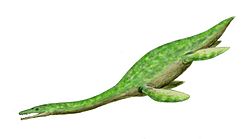| Thililua | |
|---|---|
 | |
| Thililua longicollis | |
| Scientific classification | |
| Kingdom: | |
| Phylum: | |
| Class: | |
| Superorder: | |
| Order: | |
| Suborder: | |
| Family: | Leptocleididae |
| Genus: | Thililua Bardet, Suberbiola & Jalil, 2003 |
| Species: | T. longicollis Bardet, Suberbiola & Jalil, 2003 |
| Binomial name | |
| Thililua longicollis | |
Thililua is a genus of polycotylid plesiosaur, containing one species, T. longicollis. The name Thililua is derived from that of an ancient aquatic god from local Berber mythology; longicollis refers to the animal's long neck. Thililua has been found in Late Cretaceous (early Turonian) rocks in the High Atlas mountains of Morocco in north Africa. Thililua is the first Polycotylid plesiosaur discovered in Africa, and also the first discovered that lived at a subtropical latitude.[1] In 2010, Thililua was transferred to Leptocleididae as a sister taxon to Nichollssaura.[2]
Anatomy
The type specimen of T. longicollis, which was described in 2003, consists of an almost complete skull and lower jaw, articulated with 37 vertebrae. Of these vertebrae, 30 were cervical (neck) vertebrae, which is an unusually high number compared to other Polycotylids, such as Dolichorhynchops, which had only 19 neck vertebrae, and Polycotylus, which had 26. It is believed to be an adult specimen, since some of the cranial sutures are very difficult to distinguish. Using comparisons with the head and neck length to body length ratio of a related genus, Dolichorhynchops, the estimated total length of Thililua was 5.5 to 6 metres.[1]
See also
- List of plesiosaur genera
- Timeline of plesiosaur research
References
- ^ a b Nathalie Bardet, Xabier Pereda Suberbiola and Nour-Eddine Jalil (2003). "A new polycotylid plesiosaur from the Late Cretaceous (Turonian) of Morocco". Comptes Rendus Palevol. 2 (5): 307–315. doi:10.1016/S1631-0683(03)00063-0.
- ^ Ketchum, H. F. & Benson, R. B. J. (2010). "Global interrelationships of Plesiosauria (Reptilia, Sauropterygia) and the pivotal role of taxon sampling in determining the outcome of phylogenetic analyses". Biological Reviews. 85: 361–392. doi:10.1111/j.1469-185X.2009.00107.x. PMID 20002391.
